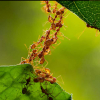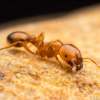- Formiculture.com
- Forums
- Gallery
- Members
- Member Map
- Chat

Seeds for Pheidole Dentata
Started By
lozow
, Mar 16 2021 6:27 PM
10 replies to this topic
#1
 Offline
-
Posted March 16 2021 - 6:27 PM
Offline
-
Posted March 16 2021 - 6:27 PM
I was wondering if anyone knows what seeds I can buy to feed to my colony of Pheidole Dentata and where to get them.
#2
 Offline
-
Posted March 16 2021 - 6:34 PM
Offline
-
Posted March 16 2021 - 6:34 PM
Pheidole dentata are part of the Pheidole fallax species group, and are not very granivorous. They are fairly unlikely to accept most types of seeds. Species in the Pheidole pilifera-group on the other hand are much more akin to eating various seeds and grains.
For P. dentata, a diet of liquid sugars and feeder insects is great. P. dentata are more of a predator/hunter species, so most of their protein comes from prey insects rather than nuts or seeds. Liquid sugars are also a great idea for them, since their majors have large social stomachs to act as repletes.
Here's a video of a wild colony swarming honey, just for fun:
Edited by CheetoLord02, March 16 2021 - 6:34 PM.
- TennesseeAnts and Chickalo like this
I like leafcutter ants. Watch The Ultimate Guide to Fungus Growing Ants:
https://youtu.be/VBH...4GkxujxMETFPt8U
This video took like over 100 hours of work, you should for sure watch it.
#3
 Offline
-
Posted March 16 2021 - 7:17 PM
Offline
-
Posted March 16 2021 - 7:17 PM
I can confirm- Cheeto is correct.
In my experience Ph. dentata will prefer roaches, crickets, superworms and large amounts of fruit flies for protein, and I've never had a captive colony accept any seeds or nuts. Their favorite source of carbohydrates in the wild comes from fruits and aphids, but in captivity honey, apples and sugar water work exceptionally.
My Main Journal | My Neivamyrmex Journal | My Ant Adoption | My YouTube
Join the TennesseeAnts Discord Server! https://discord.gg/JbKwPgs
#4
 Offline
-
Posted March 16 2021 - 7:33 PM
Offline
-
Posted March 16 2021 - 7:33 PM
Pheidole dentata are part of the Pheidole fallax species group, and are not very granivorous. They are fairly unlikely to accept most types of seeds. Species in the Pheidole pilifera-group on the other hand are much more akin to eating various seeds and grains.
For P. dentata, a diet of liquid sugars and feeder insects is great. P. dentata are more of a predator/hunter species, so most of their protein comes from prey insects rather than nuts or seeds. Liquid sugars are also a great idea for them, since their majors have large social stomachs to act as repletes.
Here's a video of a wild colony swarming honey, just for fun:
Which group is Californica in?
#5
 Offline
-
Posted March 16 2021 - 7:38 PM
Offline
-
Posted March 16 2021 - 7:38 PM
Pheidole dentata are part of the Pheidole fallax species group, and are not very granivorous. They are fairly unlikely to accept most types of seeds. Species in the Pheidole pilifera-group on the other hand are much more akin to eating various seeds and grains.
For P. dentata, a diet of liquid sugars and feeder insects is great. P. dentata are more of a predator/hunter species, so most of their protein comes from prey insects rather than nuts or seeds. Liquid sugars are also a great idea for them, since their majors have large social stomachs to act as repletes.
Here's a video of a wild colony swarming honey, just for fun:Which group is Californica in?
They are in the Ph. flavens-group if I remember correctly.
My Main Journal | My Neivamyrmex Journal | My Ant Adoption | My YouTube
Join the TennesseeAnts Discord Server! https://discord.gg/JbKwPgs
#6
 Offline
-
Posted March 16 2021 - 9:29 PM
Offline
-
Posted March 16 2021 - 9:29 PM
Pheidole dentata are part of the Pheidole fallax species group, and are not very granivorous. They are fairly unlikely to accept most types of seeds. Species in the Pheidole pilifera-group on the other hand are much more akin to eating various seeds and grains.
For P. dentata, a diet of liquid sugars and feeder insects is great. P. dentata are more of a predator/hunter species, so most of their protein comes from prey insects rather than nuts or seeds. Liquid sugars are also a great idea for them, since their majors have large social stomachs to act as repletes.
Here's a video of a wild colony swarming honey, just for fun:
Which group is Californica in?
Actually, P. californica are in pilifera-group. They'll readily accept seeds as part of their diet.
I like leafcutter ants. Watch The Ultimate Guide to Fungus Growing Ants:
https://youtu.be/VBH...4GkxujxMETFPt8U
This video took like over 100 hours of work, you should for sure watch it.
#7
 Offline
-
Posted March 16 2021 - 9:37 PM
Offline
-
Posted March 16 2021 - 9:37 PM
Is the Pheidole fervens species group similar to the fallax group, or will they also take grains and seeds?
#8
 Offline
-
Posted March 17 2021 - 6:16 AM
Offline
-
Posted March 17 2021 - 6:16 AM
Actually, P. californica are in pilifera-group. They'll readily accept seeds as part of their diet.Which group is Californica in?Pheidole dentata are part of the Pheidole fallax species group, and are not very granivorous. They are fairly unlikely to accept most types of seeds. Species in the Pheidole pilifera-group on the other hand are much more akin to eating various seeds and grains.
For P. dentata, a diet of liquid sugars and feeder insects is great. P. dentata are more of a predator/hunter species, so most of their protein comes from prey insects rather than nuts or seeds. Liquid sugars are also a great idea for them, since their majors have large social stomachs to act as repletes.
Here's a video of a wild colony swarming honey, just for fun:
I think I actually knew that- though I'm not sure why it didn't come to me earlier, lol.
My Main Journal | My Neivamyrmex Journal | My Ant Adoption | My YouTube
Join the TennesseeAnts Discord Server! https://discord.gg/JbKwPgs
#9
 Offline
-
Posted March 17 2021 - 7:24 AM
Offline
-
Posted March 17 2021 - 7:24 AM
Ph. navigans is in the flavens group, and I have some experience in keeping them. Their preferred foods are most definitely regular proteins, instead of seeds. In the wild, where large protein sources are uncommon(argentines everywhere), they will accept seeds with abandon. In captivity, the most they will do, at least in my experience, is send a couple workers who will maybe chew a few small pieces off of the seed. I imagine it is possible to feed a colony very small amounts of insect protein, as that would probably encourage them to eat seeds more, but seeing as they seem to prefer insects, that might not be beneficial to their growth.
- TennesseeAnts likes this
Hi there! I went on a 6 month or so hiatus, in part due, and in part cause of the death of my colonies.
However, I went back to the Sierras, and restarted my collection, which is now as follows:
Aphaenogaster uinta, Camponotus vicinus, Camponotus modoc, Formica cf. aserva, Formica cf. micropthalma, Formica cf. manni, Formica subpolita, Formica cf. subaenescens, Lasius americanus, Manica invidia, Pogonomyrmex salinus, Pogonomyrmex sp. 1, Solenopsis validiuscula, & Solenopsis sp. 3 (new Sierra variant).
#10
 Offline
-
Posted March 17 2021 - 11:43 AM
Offline
-
Posted March 17 2021 - 11:43 AM
This thread is making me think I should make a guide to North American Pheidole species groups. That one would take quite a bit more research than the fungus grower guide, though.
- TennesseeAnts and lozow like this
I like leafcutter ants. Watch The Ultimate Guide to Fungus Growing Ants:
https://youtu.be/VBH...4GkxujxMETFPt8U
This video took like over 100 hours of work, you should for sure watch it.
#11
 Offline
-
Posted March 17 2021 - 11:45 AM
Offline
-
Posted March 17 2021 - 11:45 AM
This thread is making me think I should make a guide to North American Pheidole species groups. That one would take quite a bit more research than the fungus grower guide, though.
Drew should move your fungus grower guide to the care sheet subforum if he hasn't already.
1 user(s) are reading this topic
0 members, 1 guests, 0 anonymous users




















